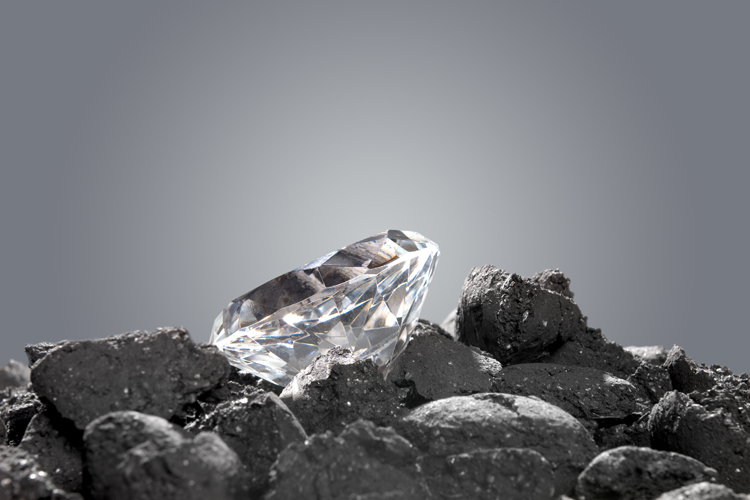Pure, fiery, mythical, and ultimately perfect, diamond is the most highly prized of all gemstones and the hardest mineral on earth.
The Greek word adamas is the origin of the name diamond. It means unconquerable or indestructible in reference to its extraordinary hardness.
The solidity of this gem is incomparable: it has a cutting resistance 140 times superior to the next hardest gemstones, ruby and sapphire.
The secret to the precious gemstone’s unique hardness and other remarkable physical qualities lies in its atomic structure.
Each atom is connected to four other equidistant atoms, creating a tightly bonded structure.
Diamond crystals are pure carbon, developing on an octahedral shape with rounded edges and faintly convex surfaces.
They are frequently well-formed because of the uniform arrangement of their carbon atoms.
While colorless diamonds are the most used in jewelry, the most famous of all gemstones can occur in all colors, from the most common yellowish to brown, black, or the rare blue.
The rarest colors are natural red and green, only superseded by pure violet and orange varieties.
These native minerals are formed at great depth, very high temperatures, and high pressures.
The Earth’s mantle, below continental masses, holds the right conditions for them to crystallize, usually more than 95 miles (150 kilometers) under the surface.
Much more ancient than the rocks in which they are discovered, the gems were brought to the surface by deep-source volcanic eruptions and, with gradual erosion, the rare volcanic rocks containing diamonds – kimberlite and lamproite – were exposed.
Hardness Level: 10
The sparkling crystals can be mined in primary or secondary deposits.
The primary deposits are the kimberlite or lamproite pipes. The secondary deposits are alluvial gravel and glacial tills, where diamonds redeposit after eroding from a kimberlite matrix.
The first sources of diamonds were alluvial deposits in India and later Brazil.
After the discovery of primary sources in South Africa in the 1870s, the country supplanted Brazil and became the leading center of paragon trade and production until about 1970.
The former Kimberley mine was South Africa’s most notorious pipe – 14.5 million carats of diamonds were discovered there.
Today, the major suppliers are Botswana, Australia, Russia, and Congo.
Diamonds rank at the top of the Mohs scale, with a level 10 of hardness, and display a perfect cleavage. The value of white diamonds is determined by Four C’s: color, cut, clarity, and carat.
The most precious diamonds are chemically pure and absolutely colorless, flawless, with no visible blemishes or inclusions under a 10x loupe, precisely and proportionally cut, fully revealing the pure fire of the gem, and large, since larger diamonds are rarer and, therefore, more coveted.
The rare strongly colored paragons, such as green, blue, red, purple, or orange, called fancy colors, are individually valued and reach collector’s prices.
The history of the diamond is merged with the development of the brilliant cut, the one that best shows the gem’s superb fire and luster.
The artistry of the cut is the only man-influenced aspect of a diamond’s value and can affect it.
Diamonds can be imitated by other colorless stones, glass, or synthetic gems. Synthetic cubic zirconia is the most common diamond simulant.
Famous Diamonds
- The Cullinan I, or Star of Africa: it’s the largest polished white paragon in the world, with 530.20 carats. It was cut from the biggest gem-quality diamond ever discovered, weighing 3,106 carats. Named after Sir Thomas Cullinan, the gem is in the scepter of the English king’s insignia;
- The Koh-I-Noor Diamond: meaning Mountain of Light, the Koh-I-Noor is a large white diamond weighing 108.92 carats. It originally belonged to the Indian Raj but finally became a possession of Queen Victoria after the conquest of Punjab by the British;
- The Hope Diamond: an extremely rare gemstone weighing 42.45 carats. It was named after Henry Ph. Hope, the banker who bought it in the 19th century;
- Golden Jubilee Diamond: the world’s largest faceted diamond, with 545.67 carats. It was discovered in the same mine as the Cullinan I, the Premier Mine in South Africa;
- De Beers Centenary Diamond: weighing 273.85 carats, it is internally and externally flawless and graded as a D in color by the Gemological Institute of America, the highest grade of colorless paragons;
Diamond | Physical Properties
Chemical Composition: C
Cleavage: Perfect Octahedral
Color: Colorless, Yellow, Brown, Blue, Orange Black, Green, Pink
Crystal System: Cubic
Fracture: Conchoidal
Luster: Adamantine
Mohs Hardness: 10
Specific Gravity: 3.4-3.5
Transparency: Transparent to Opaque




